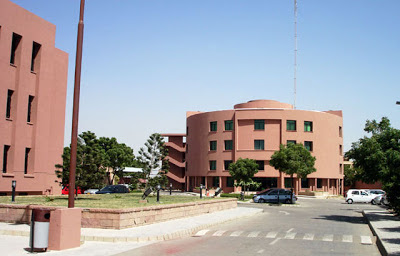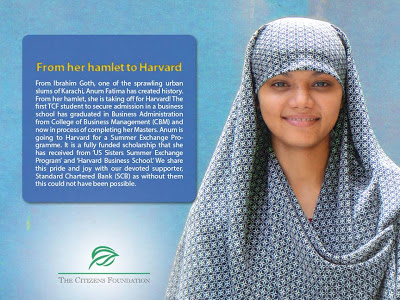PakAlumni Worldwide: The Global Social Network
The Global Social Network
Karachi Slum Girl Goes to Harvard Business School
Anum Fatima, a resident of Ibrahim Goth slum located near Karachi's Steel Town, is making history; she is going to Harvard Business School this summer as part of a student exchange program.
Anum's father is employed as a driver and her mother works as a maid. The slum school she attended is run by The Citizen's Foundation (TCF), a private foundation. From 5 schools in Karachi in 1995, TCF has expanded to 910 purpose-built schools with 126,000 students in 97 towns and cities across Pakistan.
 |
| Institute of Business Management (IoBM) Karachi |
After graduating from the TCF school located near her slum, Fatima has completed her BBA in Human Resource. She is currently attending College of Business Management (CBM) of the Institute of Business Management (IoBM), a private Business School in Karachi.
Anum is breaking many stereotypes about Pakistani women, particularly poor women, by studying business management at top business schools in Pakistan and the United States. She told a news reporter that when she broke the news to her father, he did not know what Harvard was. “When he went to work that day, he asked his boss, who told him what a tremendous achievement it was,” she said.
Although it's the first time that a TCF grad is going to Harvard, the Foundation schools have had many success stories of its graduates from poor families who have gone on to attend professional schools to become doctors, engineers, lawyers, teachers and business executives.
In spite of its many failings in adequately funding human development, Pakistan has continued to offer much greater upward economic and social mobility
to its citizens than neighboring India over the last two decades. Since 1990, Pakistan's middle
class had expanded by 36.5% and India's by only 12.8%, according to an ADB report titled "Asia's Emerging Middle Class: Past, Present And ...
New York Times' Sabrina Tavernise described the rise of Pakistan's middle class in a story from Pakistani town of Muzaffargarh in the following words:
For years, feudal lords reigned supreme, serving as the police, the
judge and the political leader. Plantations had jails, and political
seats were practically owned by families.
Instead of midwifing democracy, these aristocrats obstructed it, ignoring the needs of rural Pakistanis, half of whom are still landless and desperately poor more than 60 years after Pakistan became a state.
But changes began to erode the aristocrats’ power. Cities sprouted, with jobs in construction and industry. Large-scale
farms eclipsed old-fashioned plantations. Vast hereditary lands
splintered among generations of sons, and many aristocratic families
left the country for cities, living beyond their means off sales of
their remaining lands. Mobile labor has also reduced dependence on
aristocratic families.
In Punjab, the country’s most populous
province, and its most economically advanced, the number of national
lawmakers from feudal families shrank to 25 percent in 2008 from 42
percent in 1970, according to a count conducted by Mubashir Hassan, a
former finance minister, and The New York Times.
“Feudals
are a dying breed,” said S. Akbar Zaidi, a Karachi-based fellow with
the Carnegie Foundation. “They have no power outside the walls of their
castles.”
GeoTV is illustrating this welcome phenomenon of upward social mobility in Pakistan with a series of motivational "Zara Sochiey" videos on young men and women who have risen from humble origins to achieve significant successes in recent years. Each individual portrayed in the series has overcome adversity and focused on acquiring education as a ticket to improve his or her economic and social situation.
GeoTV videos feature a number of young men and women, including Saima Bilal, Kashif Faiq, Qaisar Abbas and many others, to inspire and encourage other Pakistanis to pursue their dreams against all odds.
Contrary to the incessant talk of doom and gloom, the fact is that the level of educational attainment has been rising in recent decades. In fact, Pakistan has been increasing enrollment of students in schools at a faster
rate since 1990 than India, according to data compiled and reported by Harvard University researchers Robert... . In 1990, there were 66.2% of Pakistanis vs
51.6% of Indians in 15+ age group who had had no schooling. In 2000, there were 60.2%
Pakistanis vs 43% Indians with no schooling. In 2010, Pakistan reduced
it to 38% vs India's 32.7%.

As of 2010, there are 380 (vs 327 Indians) out of every 1000 Pakistanis
age 15 and above
who have never had any formal schooling. Of the remaining 620 (vs 673
Indians) who
enrolled in school, 22 (vs 20 Indians) dropped out before finishing
primary school, and
the remaining 598 (vs 653 Indians) completed it. There are 401 (vs 465
Indians) out of every 1000
Pakistanis who made it to secondary school. 290 (vs 69 Indians)
completed secondary school while 111 (vs. 394 Indians) dropped out.
Only 55 (vs 58 Indians) made it to college out of which 39 (vs 31
Indians) graduated with a degree.
Education and development efforts are beginning to bear fruit even in remote areas of Pakistan, including Federally Administered Tribal Areas. The Guardian newspaper recently reported that FATA's Bajaur agency alone has 616 school with over 60,000 boys and girls receiving take-home rations. Two new university campuses have been approved for FATA region and thousands of kilometers of new roads are being constructed. After a recent visit to FATA, Indian journalist Hindol Sengupta wrote in The Hindu newspaper that "even Bajaur has a higher road density than India"
Prior to significant boost in public spending on education during Musharraf years, the number of private schools in Pakistan grew 10 fold from about 3000 in 1983 to over 30,000 in 2000. Primary school enrollment in 1983 has increased 937%, far greater than the 57%
population increase in the last two decades.
With current public education funding at just 2% of GDP, the Pakistani government is clearly abdicating its responsibility of educating poor children. Fortunately, there are a number of highly committed individuals and organizations like The Citizens Foundation (TCF) and the Human Development Foundation (HDF) which are very active in raising funds and building and operating schools to improve the situation in Pakistan. It is important that all of us who care for the future of Pakistan should generously help these and similar other organizations.
Related Links:
Haq's Musings
Pakistan Must Fix Primary Education
Pakistan Human Development Since 1980s
Working Women in Pakistan
Pakistan's Out-of-School Children
Pakistan's Human Capital
Status of Women in Pakistan
Upwardly Mobile Pakistan
Teach For Pakistan
Business Education in Pakistan
Developing Pakistan's Intellectual Capital
Intellectual Wealth of Nations
Resilient Pakistan Defies Doomsayers
-
Comment by Riaz Haq on June 11, 2023 at 10:44am
-
The education spending multiplier: Evidence from schools in Pakistan
Tahir Andrabi Natalie Bau Jishnu Das Naureen Karachiwalla Asim Ijaz Khwaja / 11 Jun 2023
https://cepr.org/voxeu/columns/education-spending-multiplier-eviden...
Conclusion
Our first main result, that grants to public schools increased test scores, contrasts with an earlier literature where null effects were more common (e.g. Das et. al. 2013, Mbiti et. al. 2019). We may now need to move beyond such ‘grant pessimism’ precisely because we have learned from the previous failures. In contrast to previous grants in India and Zambia, which were offset by parents because they were small, the grants here were much larger and could be used for infrastructure improvements (Das et al. 2013). Indeed, grant size and test score improvements are positively correlated in this programme.
In addition, the schools could use the grants to hire teachers on temporary contracts. Again, this policy reflected what we had learned from prior research, which has consistently shown that teachers hired on temporary contracts may be more effective because they face stronger career incentives (Duflo et al. 2015, Muralidharan and Sundararaman 2013, Bau and Das 2020).
Finally, to avoid the problems of centrally mandated expenditures that are not responsive to local needs as well as potential misuse, schools worked with a reputed NGO and a reconstituted school council to determine investment priorities that were then funded through the grant.
Beyond showing that public school grants can increase test scores, this study demonstrates the existence of a large education multiplier from the public to the private sector. Hundreds of millions of children live in neighbourhoods/villages with substantial school choice, and many of the schools that they can choose from are private schools that survive on school fees. In this highly interconnected world, the idea that there are `programmes for public schools’ and `programmes for private schools’ and that the two can be kept separate is no longer tenable. Failing to account for the effect of public sector interventions on the private sector - ex-ante in the design of the programme and ex-post in its evaluation – leads to less effective interventions and inaccurate evaluations. In our case, restricting the focus to public schools would have led to an entirely different estimate of the programme’s cost effectiveness.
While we show that taking the private sector into account is crucial, spillovers on private schools need not always be positive. Dinerstein and Smith (2021) find that in New York City a public-school improvement programme led to children leaving private schools, and these schools then shutting down. In the Dominican Republic, Nielson et al. (2020) show that a huge school construction programme led to the closure of some private schools, but with quality improvements among the survivors. But across all these studies, the clear message is that the days when public school programmes would have effects only on public schools are over. We need to think of the full schooling environment and not just the part in which we have intervened.
Comment
- ‹ Previous
- 1
- 2
- 3
- Next ›
Twitter Feed
Live Traffic Feed
Sponsored Links
South Asia Investor Review
Investor Information Blog
Haq's Musings
Riaz Haq's Current Affairs Blog
Please Bookmark This Page!
Blog Posts
Pakistanis' Insatiable Appetite For Smartphones
Samsung is seeing strong demand for its locally assembled Galaxy S24 smartphones and tablets in Pakistan, according to Bloomberg. The company said it is struggling to meet demand. Pakistan’s mobile phone industry produced 21 million handsets while its smartphone imports surged over 100% in the last fiscal year, according to …
ContinuePosted by Riaz Haq on April 26, 2024 at 7:09pm
Pakistani Student Enrollment in US Universities Hits All Time High
Pakistani student enrollment in America's institutions of higher learning rose 16% last year, outpacing the record 12% growth in the number of international students hosted by the country. This puts Pakistan among eight sources in the top 20 countries with the largest increases in US enrollment. India saw the biggest increase at 35%, followed by Ghana 32%, Bangladesh and…
ContinuePosted by Riaz Haq on April 1, 2024 at 5:00pm
© 2024 Created by Riaz Haq.
Powered by
![]()



You need to be a member of PakAlumni Worldwide: The Global Social Network to add comments!
Join PakAlumni Worldwide: The Global Social Network